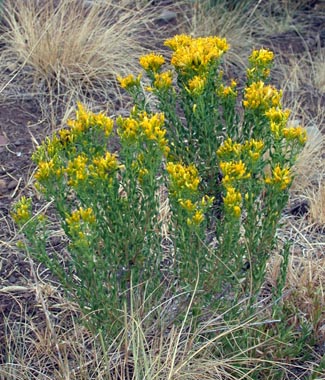Yellow Rabbitbrush

Common Name(s):
Yellow Rabbitbrush
Douglas Rabbitbrush
Green Rabbitbrush
Scientific Name:
Chrysothamnus viscidiflorus (Hook.) Nutt.
Scientific Name Synonyms:
None known
Symbol:
CHVI8
Description:
Life Span: Perennial
Origin: Native
Season: Deciduous
Growth Characteristics: Douglas rabbitbrush is an erect shrub, branching from near the base, with a rounded crown, growing 1 to 3 ½ feet tall. It flowers July to September and reproduces from seed and vegetatively by vigorous sprouting.
Flowers/Inflorescence: Inflorescences are in flat-top or round clusters with many branches. The flowers are small and yellow.
Fruits/Seeds: Fruit is a wedge-shaped achene that is flattened, light brown, with 5 ribs. It is pubescent and slightly barbed, and produces an abundance of small, viable, plumed seeds that are easily dispersed by wind.
Leaves: Alternate, green, and usually twisted.
Stems: Twigs are mostly erect, stiff, brittle, striate, greenish or white glabrous, and semi-glossy. The trunk bark is light brown and shreddy.
Ecological Adaptions:
Occurs in dry, open valley and on hillsides in sagebrush, ponderosa pine, lodgepole pine, or aspen belts at elevations between 2,600 and 11,000 feet. It is well adapted to drought and exhibits salt tolerance.
Soils: Dry, well-drained, medium to coarse textured soils. It is common on alkaline soils.
Associated Species: Big sagebrush, aspen, ponderosa pine, lodgepole pine, winterfat, and cheatgrass.
Uses and Management:
Douglas rabbitbrush has little to no value as a forage species. Sheep and cattle occasionally use it for browse when other feed is not available. Deer browse lightly on it in the summer and winter. Elk utilize it in the winter.
Douglas rabbitbrush can be a somewhat weedy plant, increasing where there has been serious damage to the more desirable forage. It quickly and aggressively invades disturbed, open sites including burns and overgrazed rangelands.
Southwest Indians chewed the roots of Douglas rabbitbrush as gum. It contains rubber, especially when growing in alkali soils.

